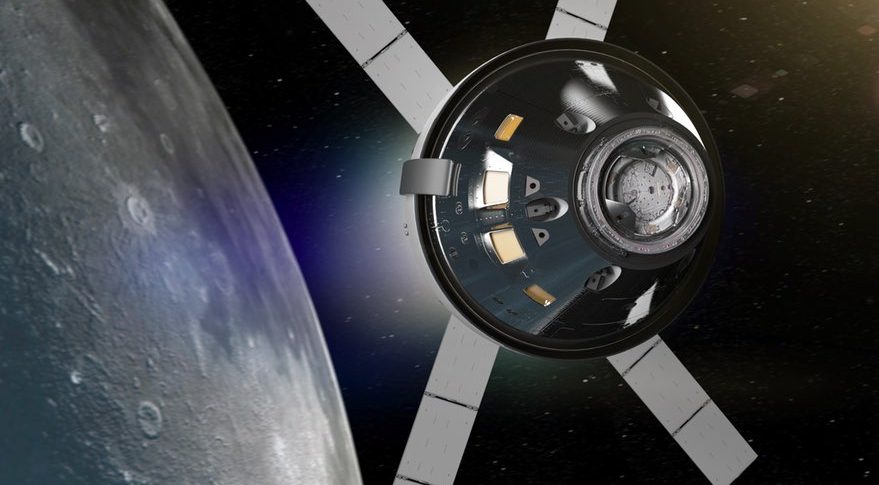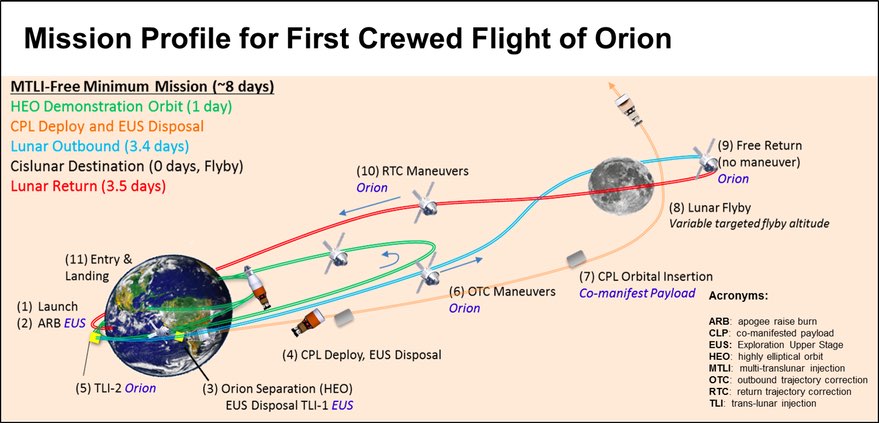NASA Considers Shorter First Crewed SLS/Orion Mission

WASHINGTON — The first crewed flight of NASA's Orion spacecraft may fly a shorter mission than previously considered, with only a loop around the moon rather than an extended stay there.
In a presentation to a Nov. 30 meeting of the NASA Advisory Council in Palmdale, California, Bill Gerstenmaier, NASA associate administrator for human exploration and operations, discussed what he described as a new proposal for Exploration Mission 2 (EM-2) that would last eight days.
The concept, called the multi-translunar injection free minimum mission, would initially place the the Orion spacecraft and its Exploration Upper Stage (EUS) into an elliptical orbit around the Earth with an apogee of 35,000 kilometers. After spending one day in that orbit, the spacecraft would separate from the EUS and use its service module engine for a final burn to send the spacecraft towards the moon. [Orion Explained: NASA's Multi-Purpose Crew Vehicle (Infographic)]
Orion would fly on a "free return" trajectory around the moon without going into orbit and without requiring another engine burn. The mission would end with a return to Earth eight days after launch, but with an option to extend the mission to up to 21 days.
This approach differs from earlier concepts for EM-2. A design reference mission for EM-2 presented by NASA at an American Astronautical Society conference in February discussed a concept for a mission lasting 9 to 13 days. The Orion would spend three to six days going out to the moon, entering a high lunar orbit for three days before a trip back of three to six days.
The new mission plan, Gerstenmaier said, is based on a better understanding of the risks associated with the flight. "We've effectively designed this mission to be commensurate with the amount of risk we're taking with crew on the vehicle for the first time," he said. "We've tailored the mission to be appropriate with the risk we're willing to take."

One specific issue with EM-2 he mentioned is the spacecraft's life support system. "This is the first time this life support system will be used," he said. Testing it in Earth orbit first, he said, reduces the risks of problems if it malfunctions. "If something goes wrong with the life support system, we have a graceful way to abort."
Get the Space.com Newsletter
Breaking space news, the latest updates on rocket launches, skywatching events and more!
The use of a free return trajectory also minimizes risk, as it takes Orion around the moon and back to Earth without the need to perform an engine burn in the vicinity of the moon. "That's why we consciously did a free return," Gerstenmaier said.
That approach appeared to have support from members of the committee. "In our minds, we were thinking we might go to lunar distant retrograde orbit on this mission. There was some thought we might just go immediately from low Earth orbit all the way to the moon and stay there for a while in orbit," said former astronaut Ken Bowersox, interim chair of the NASA Advisory Council, of EM-2.
Bowersox said he saw benefits of the revised approach, noting it offered "more vigorous" test of the vehicle and upper stage with safety for the crew. "Anywhere after you've established an orbit, if you have an EUS failure, the service module should be able to do the burn to get you home."
The new approach for EM-2 does not affect plans for the initial SLS/Orion mission, EM-1, scheduled for launch without a crew in late 2018. Gerstenmaier said that mission will go into a distant retrograde orbit around the moon and stay there for several days before returning. That mission is currently planned to last 25 or 26 days.
"The idea is to really stress the heck out of this Orion capsule and the service module," Gerstenmaier said of the EM-1 mission plan. "We want to really wring out this vehicle without a crew on board."
A successful EM-2 mission, he added, would allow for more ambitious crewed missions in cislunar space on subsequent flight. A chart he showed at the meeting listed plans for missions EM-3 through EM-10, flying at a rate of one a year from 2023 to 2030. EM-6, in 2026, was earmarked for a crewed mission to the boulder returned to cislunar space as part of the Asteroid Redirect Mission. The others were listed as "Proving Ground" missions, which will likely involve a series of missions of increasing duration to a habitat in cislunar space.
Gerstenmaier said he would like to move up EM-3 to 2022, assuming EM-2 launches in 2021, but can't fit that into projected budgets. "We're working to understand our production and operations costs to see if we can get that down to move that to 2022," he said.
As part of that effort, NASA issued a request for information (RFI) Nov. 17 regarding the "long term efficiency and sustainability" of NASA's exploration programs, including SLS and Orion as well as associated ground systems. "Given NASA's assumption of flat funding levels," the document states, minimizing costs for those systems "is critical to free resources for re-investment" in other exploration capabilities.
The release of the RFI attracted some industry attention because it appeared to suggest NASA would be open to replacing SLS or Orion with alternatives. "Competing exploration services in the mid-2020s timeframe and beyond if the market demonstrates such services are available, reliable, and consistent with NASA architectural needs" was one suggested idea included in the document.
However, NASA Administrator Charles Bolden said at the council meeting that was not the intent of the document. "This RFI turned out to be somewhat controversial because I don't think people understood it fully," he said.
He compared it to the mid-1990s creation of United Space Alliance, the Boeing-Lockheed Martin joint venture that took over space shuttle operations in an effort to reduce costs. "That's kind of the same system that we're looking at, if it's feasible, for SLS and Orion and the ground systems," Bolden said. "We're always looking for efficiencies, and that was the purpose of the RFI."
This story was provided by SpaceNews, dedicated to covering all aspects of the space industry.
Join our Space Forums to keep talking space on the latest missions, night sky and more! And if you have a news tip, correction or comment, let us know at: community@space.com.

Jeff Foust is a Senior Staff Writer at SpaceNews, a space industry news magazine and website, where he writes about space policy, commercial spaceflight and other aerospace industry topics. Jeff has a Ph.D. in planetary sciences from the Massachusetts Institute of Technology and earned a bachelor's degree in geophysics and planetary science from the California Institute of Technology. You can see Jeff's latest projects by following him on Twitter.

